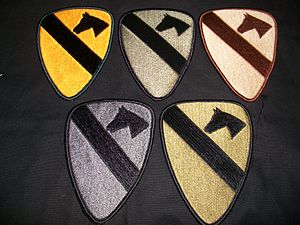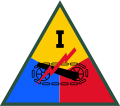Shoulder sleeve insignia
This article needs additional citations for verification. (February 2013) |
Cloth |
Shoulder sleeve insignia (SSI) are distinctive cloth patches worn on the left sleeve of the United States Army uniform just below the shoulder seam by soldiers assigned to divisions, corps, armies, and other specifically authorized organizations. They are also worn on the right sleeve by soldiers to indicate former overseas service with certain units during periods of U.S. military operations in hostile conditions (MOHC).
Versions
Colored
Shoulder sleeve insignia were often designed with intricate designs including bright colors, when created. Because these bright colors and designs risk standing out when a soldier is in combat or in hiding, the shoulder sleeve insignia in its color form was commonly only worn on the
"Full color" SSI were only worn on the brown service coat during the 1940s, and on the green "Class A" uniform and on the
Subdued
The subdued version of the SSI created for the
The subdued version created for the
The subdued version created for the
colors for some details. Unlike previous patches, the ACU SSI are velcro-backed, designed to attach to the velcro pockets on the shoulder of the uniform, instead of being sewn on. This makes them easier to remove and replace.Since the development of the Operational Camouflage Pattern (OCP) uniform (commonly known as MultiCam as it is derived from Crye Precision's proprietary pattern) new SSI have been procured where the "Foliage" green of the ACU SSI is replaced by "Bagby" green. Velcro remains the method for attaching the SSI to the uniform.
Wear
The SSI is typically worn on the left upper arm, just below the uniform's shoulder seam on all but the ACU. The most common place for the SSI to be worn on the ACU is on the upper sleeve, attached using a
Which SSI is worn depends on the
Military operations in hostile conditions

Those soldiers who are combat veterans are authorized permanent wear of the SSI of the unit they fought with on their right shoulder. This shoulder sleeve insignia recognizes "former wartime service" and is frequently called a "combat patch". Per Army Regulation 670-1, a soldier is authorized to wear the SSI of their higher headquarters. This is not dependent on whether or not the higher headquarters deployed, or to whom the soldier was attached throughout his/her deployment.
With the
Entire formations of soldiers are rarely deployed to the same command structure. For example, a battalion from a separate support brigade may be attached to a brigade combat team during on deployment, which, in turn, would be attached to a different division headquarters. It is a misconception that in that deployment, soldiers in the battalion could earn three patches at once; the patch of their regular headquarters (the separate brigade), the patch of the brigade combat team that they were attached to, and the patch of the division that the brigade combat team was attached to. In actuality, the regulation states that soldiers will wear the shoulder sleeve insignia of former wartime service of the lowest deployed echelon authorized its own distinctive SSI, which applies to divisions, separate brigades, and a handful of battalions. After March 27, 2007 the policy was changed to allow units of company level and higher to wear the SSI of their regular headquarters as a combat patch. This policy change also means that units above company level no longer receive multiple combat patches for single deployments, in turn simplifying what combat patch soldiers are actually entitled to wear.
Although all U.S. Army
There is no time-in-theater requirement for wear of the SSIFWTS and orders are not created to authorize it. U.S. soldiers are also not required to wear a SSIFWTS, and if they can wear more than one SSIFWTS then soldiers can alternate from one to another, but they cannot wear more than one at a time.
History
The
By
Most US formations had unique patches which varied greatly in size and makeup, with the exception of U.S. armored divisions (as well as 1st Armored Corps and the U.S. Army Armor Center & School), all of which adopted the same patch (a yellow, red and blue triangle with a symbol for armor in the middle). Each division and I Armored Corps then included its number in the upper yellow portion of the patch to distinguish it. The SSIs of those armored units which survived into the Cold War became irregular pentagons (some units later than others) with the addition of rectangular section at the bottom, bearing the division's nickname or "U.S. Army Armor Center".
-
The 81st Infantry Division "Wildcat" insignia; the first approved SSI.
-
1st Armored Corps insignia.
-
1st Armored Division insignia showing division nickname.
-
4th Armored Division insignia. The division chose not to add a nickname as befit their motto: Name Enough!
-
The U.S. Army Armored School insignia.
-
U.S. soldiers wearing the DCU uniform with the 25th Infantry Division SSI.
-
A Soldier wears the173rd Airborne Brigade Combat TeamSSI on his ACU uniform while serving in Afghanistan
-
A soldier with the SSI of theInterceptor Body Armorshoulder pad.
-
A soldier with the SSI of theMICH TC-2000 Combat Helmet.
-
Half scale insignia of the 1st Maneuver Enhancement Brigade worn on the right side of an Advanced Combat Helmet.
-
SSI for the 85th Infantry Division. WW I, WWII, 1970-1986, and present
-
SSI for the 91st Infantry Division in World War II
-
Variation SSI for the 91st Infantry Division in World War II
-
SSI for the 91st Infantry Division in World War II
Subdued patches and insignia were introduced during the Vietnam War and were made mandatory for wear on the field uniform starting July 1, 1970.[3]
SSIs are generally authorized only for units commanded by a general officer. In the early 1960s, separate armor regiments began creating SSI, and the number of separate brigades increased. Today, most separate brigades have their own SSI, but those brigades permanently assigned to divisions do not. A handful of smaller units have SSI (including the U.S. Army's
See also
- Distinctive unit insignia
- Emblems of the United States Air Force
- Divisional Insignia of the British Army
- Formation badges for the British Armyequivalent
- Tactical recognition flash
Shoulder sleeve insignia galleries
- Field Army insignia of the United States Army
- Corps Insignia of the United States Army
- Division insignia of the United States Army
- Brigade insignia of the United States Army
- Miscellaneous shoulder sleeve insignia of the United States Army
References
- ^ Jahner, Kyle (August 7, 2017). "The end of the Green Service Uniform: 1954-2015". armytimes.com. Retrieved April 9, 2018.
- ^ a b "ALARACT 055/2007 AR 670-1, 3 Feb 05, wear and appearance of army uniforms and insignia" (PDF). PenFed Credit Union. Archived from the original (PDF) on March 27, 2009.
- ^ United States Department of the Army. (January 1971). Uniform and Insignia, Male Personnel: Army Regulation 670-5, Chapter 15-1.
Further reading
- Dalessandro, Robert J. & Knapp, Michael G., Organization and Insignia of the American Expeditionary Forces, 1917–1923, (Atglen, PA: Schiffer Publishing) 2008.
External links
 Media related to Shoulder sleeve insignia at Wikimedia Commons
Media related to Shoulder sleeve insignia at Wikimedia Commons- US Army Patches & Crests at Flickr













